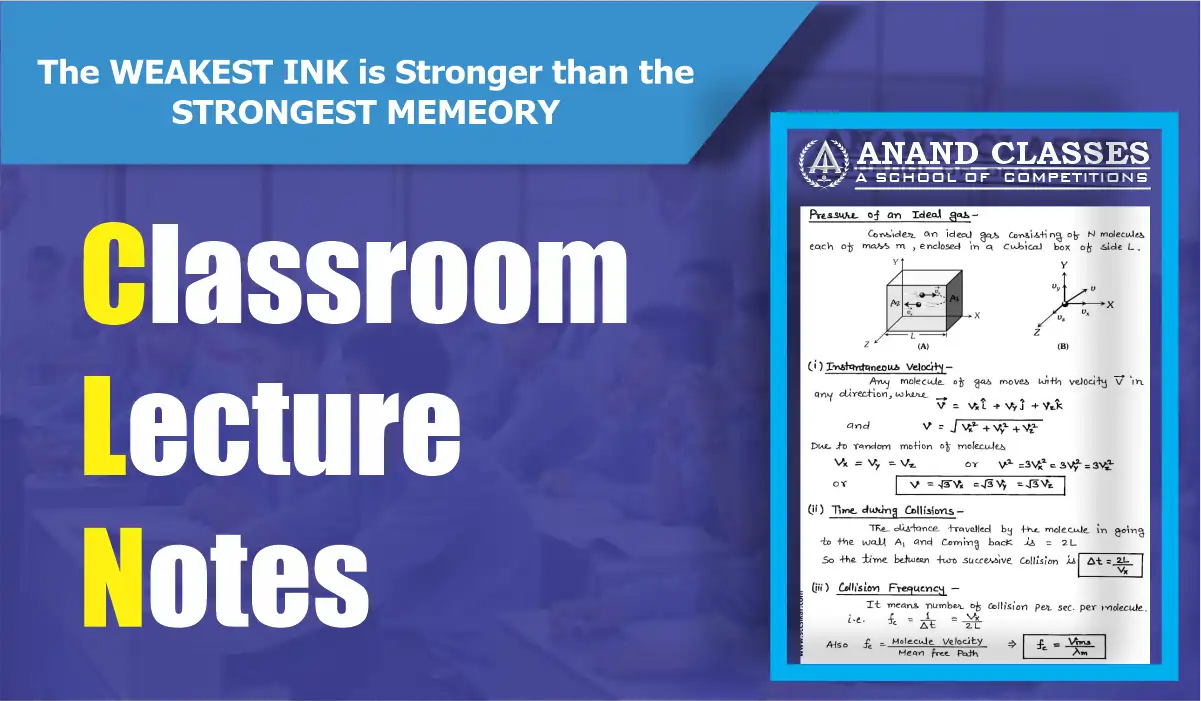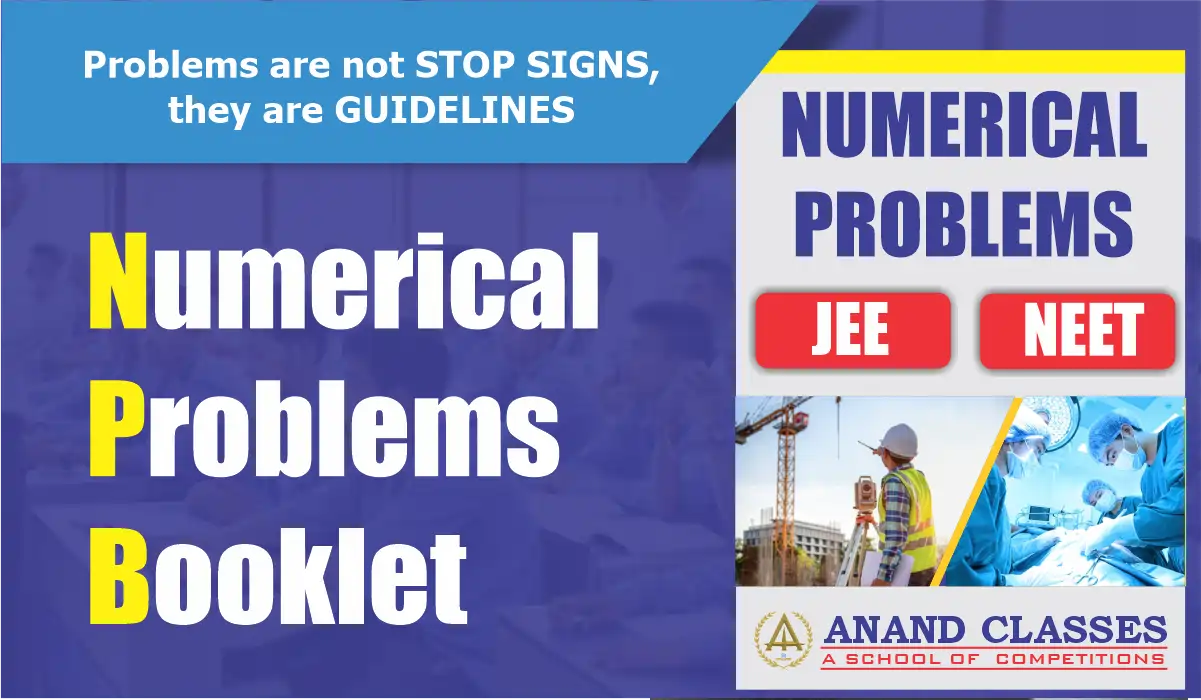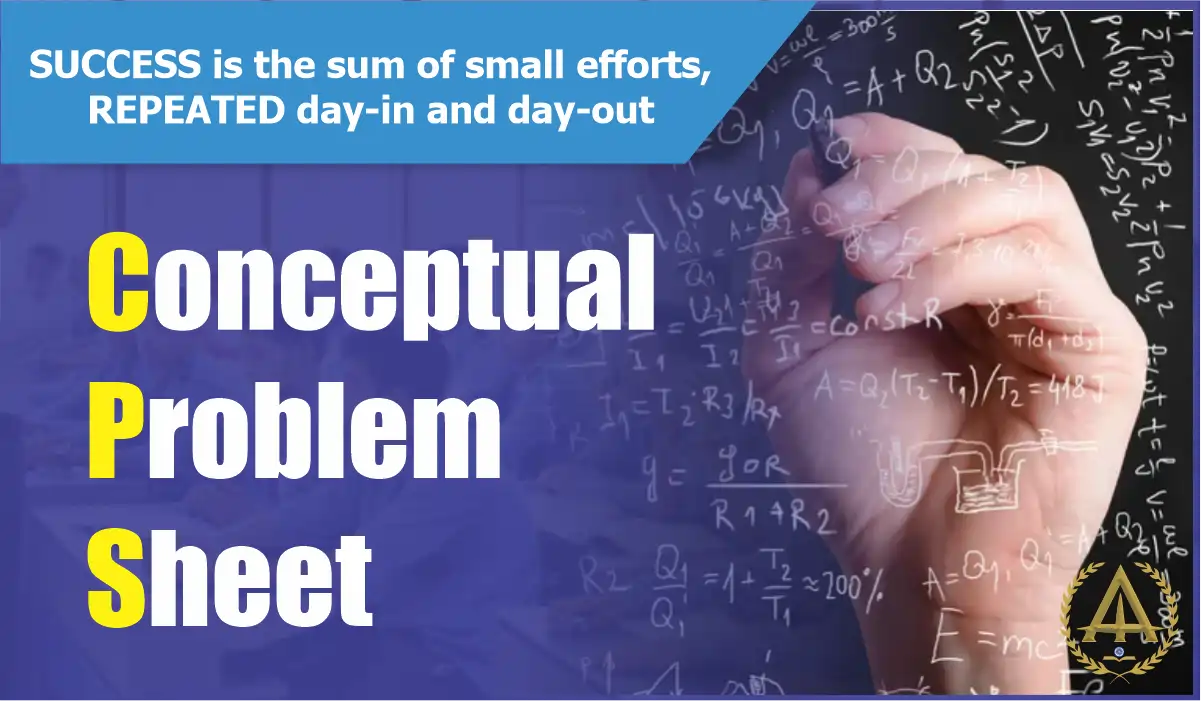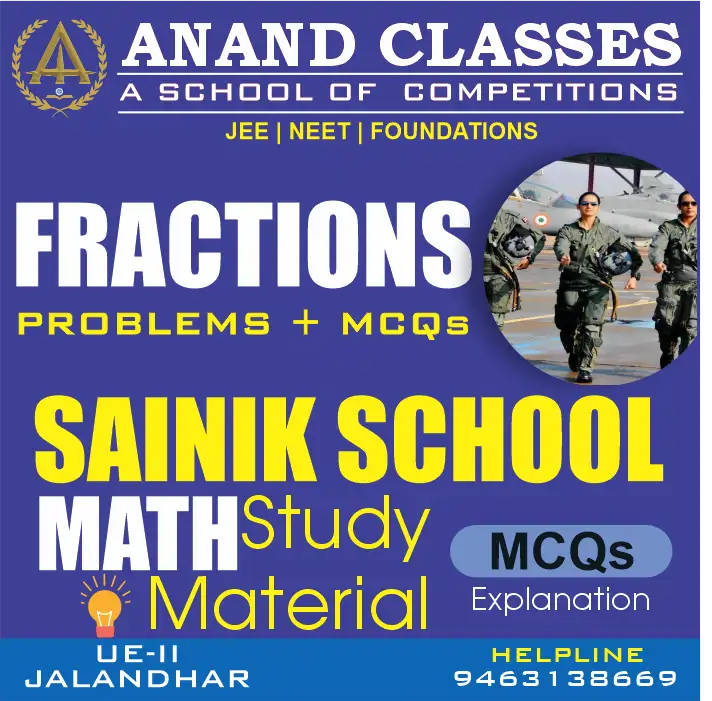Fraction MCQs-Sainik School Exam Class 6 Math Notes Study Material Book pdf download free-ANAND CLASSES
Sainik School (AISSEE) Class 6th Mathematics Chapter-wise Notes, Examples, Practice Exercise, Q&A with Solution
This article from ANAND CLASSES contains Multiple Choice Questions (MCQs) with answers from the Chapter “Fractions” based on the latest exam pattern of All India Sainik School Entrance Exam (AISSEE) for getting admission in Class 6. This short type question-answers AISSEE Mathematics section Mcqs will help you to test your learning and get a quick revision.
SOLVED PROBLEMS
1. Compare the following fractions by using the symbol > or < or =:
(i) (7/9) and (8/13)
(ii) (11/9) and (5/9)
(iii) (37/41) and (19/30)
(iv) (17/15) and (119/105)
Solution:
(i) Given (7/9) and (8/13)
Taking LCM for 9 and 13 we get,
9 × 13 = 117
Now we convert the given fractions into its equivalent fractions, then it becomes
(7 × 13)/ (9 × 13) and (8 × 9)/ (13 × 9)
Therefore (91/117) > (72/117)
Hence (7/9) > (8/13)
(ii) Given (11/9) and (5/9)
As the denominator is equal, they form equivalent fractions.
But we know that 11 > 5
Hence (11/9) > (5/9)
(iii) Given (37/41) and (19/30)
Taking LCM for 41 and 30 we get,
30 × 41 = 1230
Now we convert the given fractions into its equivalent fractions, then it becomes
(37 × 30)/ (41 × 30) and (19 × 41)/ (30 × 41)
Therefore (1110/1230) > (779/1230)
Hence (37/41) > (19/30)
(iv) Given (17/15) and (119/105)
Taking LCM for 15 and 105 we get, 5 × 3 × 7 = 105
Now we convert the given fractions into its equivalent fractions, then it becomes
(17 × 7)/ (15 × 7) and (119/105)
Therefore (119/105) = (119/105)
Hence (17/15) = (119/105)
2. Arrange the following fractions in ascending order:
(i) (3/8), (5/6), (6/8), (2/4), (1/3)
(ii) (4/6), (3/8), (6/12), (5/16)
Solution:
(i) Given (3/8), (5/6), (6/8), (2/4), (1/3)
Now we have to arrange these in ascending order, to arrange these in ascending order we have to make those as equivalent fractions by taking LCM’s.
LCM of 8, 6, 4 and 3 is 24
Equivalent fractions are
(9/24), (20/24), (18/24), (12/24), (8/24)
We know that 8 < 9 < 12 < 18 < 20
Now arranging in ascending order
(8/24) < (9/24) < (12/24) < (18/24) < (20/24)
Hence (1/3) < (3/8) < (2/4) < (6/8) < (5/6)
(ii) Given (4/6), (3/8), (6/12), (5/16)
Now we have to arrange these in ascending order, to arrange these in ascending order we have to make those as equivalent fractions by taking LCM’s.
LCM of 8, 6, 12 and 16 is 48
Equivalent fractions are
(32/48), (15/48), (18/48), (15/48)
We know that 12 < 15 < 18 < 32
Now arranging in ascending order
(12/48) < (15/48) < (18/48) < (32/48)
(6/12) < (5/16) < (3/8) < (4/6)
3. Arrange the following fractions in descending order:
(i) (4/5), (7/10), (11/15), (17/20)
(ii) (2/7), (11/35), (9/14), (13/28)
Solution:
(i) Given (4/5), (7/10), (11/15), (17/20)
Now we have to arrange these in descending order, to arrange these in descending order we have to make those as equivalent fractions by taking LCM’s.
LCM of 5, 10, 15 and 20 is 60
Equivalent fractions are
(48/60), (42/60), (44/60), (51/60)
We know that 51 > 48 > 44 > 42
Now arranging in descending order
Hence (17/20) > (4/5) > (11/15) > (7/10)
(ii) Given (2/7), (11/35), (9/14), (13/28)
Now we have to arrange these in descending order, to arrange these in descending order we have to make those as equivalent fractions by taking LCM’s.
LCM of 7, 35, 14 and 28 is 140
Equivalent fractions are
(40/140), (44/140), (90/140), (65/140)
We know that 90 > 65 > 44 > 40
Now arranging in descending order
Hence (9/14) > (13/28) > (11/35) > (2/7)
4. Write five equivalent fraction of (3/5).
Solution:
Given (3/5)
By multiplying or dividing both the numerator and denominator so that it keeps the same value by this we can get the equivalent fractions.
(3 × 2)/ (5 × 2), (3 × 3)/ (5 × 3), (3 × 4)/ (5 × 4), (3 × 5)/ (5 × 5), (3 × 6)/ (5 × 6)
Equivalent fractions are
(6/10), (9/15), (12/20), (15/25), (18/30)
5. Find the sum:
(i) (5/8) + (3/10)
(ii) 4 3/4 + 9 2/5
(iii) (5/6) + 3 + (3/4)
(iv) 2 3/5 + 4 7/10 + 2 4/15
Solution:
(i) Given (5/8) + (3/10)
Taking LCM for 8 and 10 we get 40
Now we have to convert the given fractions into equivalent fractions with denominator 40
(5/8) + (3/10) = (5 × 5)/ (8 × 5) + (3 × 4)/ (10 × 4)
= (25/40) + (12/40)
= (37/40)
(ii) Given 4 3/4 + 9 2/5
First convert given mixed fractions into improper fractions.
4 3/4 + 9 2/5 = (19/4) + (47/5)
Taking LCM for 4 and 5 we get 20
Now we have to convert the given fractions into equivalent fractions with denominator 20
4 3/4 + 9 2/5 = (19/4) + (47/5) = (19 × 5)/ (4 × 5) + (47 × 4)/ (5 × 4)
= (95/20) + (188/20)
= (283/20)
(iii) Given (5/6) + 3 + (3/4)
Taking LCM for 6, 1 and 4 we get 12
Now we have to convert the given fractions into equivalent fractions with denominator 12
(5/6) + 3 + (3/4) = (5 × 2)/ (6 × 2) + (3 × 12)/ (1 × 12) + (3 × 3)/ (4 × 3)
= (10/12) + (36/12) + (9/12)
= (55/12)
(iv) Given 2 3/5 + 4 7/10 + 2 4/15
First convert given mixed fractions into improper fractions
2 3/5 + 4 7/10 + 2 4/15 = (13/5) + (47/10) + (34/15)
Taking LCM for 5, 10 and 15 we get 30
Now we have to convert the given fractions into equivalent fractions with denominator 30
2 3/5 + 4 7/10 + 2 4/15 = (13/5) + (47/10) + (34/15) = (13 × 6)/ (5 × 6) + (47 × 3)/ (10 × 3) + (34 × 2)/ (15 × 2)
= (78/30) + (141/30) + (68/30)
= (287/30)
6. Find the difference of:
(i) (13/24) and (7/16)
(ii) 6 and (23/3)
(iii) (21/25) and (18/20)
(iv) 3 3/10 and 2 7/15
Solution:
(i) Given (13/24) and (7/16)
To find the difference we have to make it equivalent fractions.
LCM of 24 and 16 is 48.
Now converting the given fractions into equivalent fractions with denominator 48.
(13/24) – (7/16) = (26/48) – (21/48)
= (26 – 21)/48
= (5/48)
(ii) Given 6 and (23/3)
To find the difference we have to make it equivalent fractions.
LCM of 3 and 1 is 3.
Now converting the given fractions into equivalent fractions with denominator 3.
(23/3) – 6 = (23/3) – (18/3)
= (23 – 18)/3
= (5/3)
(iii) Given (21/25) and (18/20)
To find the difference we have to make it equivalent fractions.
LCM of 25 and 20 is 100.
Now converting the given fractions into equivalent fractions with denominator 100.
(18/20) – (21/25) = (90/100) – (84/100)
= (90 – 84)/100
= 6/100
By converting it into its simplest form we get
= 3/50
(iv) Given 3 3/10 and 2 7/15
First convert given mixed fractions into improper fractions.
(33/10) and (37/15)
To find the difference we have to make it equivalent fractions.
LCM of 10 and 15 is 30.
Now converting the given fractions into equivalent fractions with denominator 30.
(33/10) – (37/15) = (99/30) – (74/30)
= (99 – 74)/30
= (25/30)
By converting it into simplest form we get
= (5/6)
7. Find the difference:
(i) (6/7) – (9/11)
(ii) 8 – (5/9)
(iii) 9 – 5 2/3
(iv) 4 3/10 – 1 2/15
Solution:
(i) Given (6/7) – (9/11)
To find the difference we have to make it equivalent fractions.
LCM of 7 and 11 is 77.
Now converting the given fractions into equivalent fractions with denominator 77.
Equivalent fractions are (66/77) and (63/77)
(6/7) – (9/11) = (66/77) – (63/77)
= (66 – 63)/77
= (3/77)
(ii) Given 8 – (5/9)
To find the difference we have to make it equivalent fractions.
LCM of 1 and 9 is 9.
Now converting the given fractions into equivalent fractions with denominator 9.
Equivalent fractions are (72/9) and (5/9)
8 – (5/9) = (72/9) – (5/9)
= (72 -5)/9
= (67/9)
(iii) Given 9 – 5 2/3
First convert the given mixed fractions into improper fractions.
We get 5 2/3 = (17/3)
To find the difference we have to make it equivalent fractions.
LCM of 1 and 3 is 3.
Now converting the given fractions into equivalent fractions with denominator 3.
Equivalent fractions are (27/3) and (17/3)
9 – 5 2/3 = (27/3) – (17/3)
= (10/3)
(iv) Given 4 3/10 – 1 2/15
First convert the given mixed fractions into improper fractions.
We get (43/10) and (17/15)
To find the difference we have to make it equivalent fractions.
LCM of 10 and 15 is 30.
Now converting the given fractions into equivalent fractions with denominator 30.
Equivalent fractions are (129/30) and (34/30)
4 3/10 – 1 2/15 = (43/10) – (17/15)
= (129/30) – (34/30)
= (129 – 34)/30
= (95/30)
= (19/6)
8. Simplify:
(i) (2/3) + (1/6) – (2/9)
(ii) 12 – 3 1/2
(iii) 7 5/6 – 4 3/8 + 2 7/12
Solution:
(i) Given (2/3) + (1/6) – (2/9)
LCM of 3, 6 and 9 is 18
Now we have to convert the given fraction into equivalent fraction with denominator 18
(2/3) + (1/6) – (2/9) = (12/18) + (3/18) – (4/18)
= (12 + 3 – 4)/18
= 11/18
(ii) Given 12 – 3 (1/2)
First convert the given mixed fraction into improper fraction we get (7/2)
LCM of 2 and 1 is 2
Now we have to convert the given fraction into equivalent fraction with denominator 2
12 – 3 1/2 = (24/2) – (7/2)
= (24 -7)/2
= (17/2)
(iii) Given 7 5/6 – 4 3/8 + 2 7/12
First convert the given mixed fraction into improper fraction we get (47/6), (35/8) and (31/12)
LCM of 12, 6 and 8 is 48
Now we have to convert the given fraction into equivalent fraction with denominator 48
7 5/6 – 4 3/8 + 2 7/12 = (47/6) – (35/8) + (31/12)
= (376/48) – (210/48) + (124/48)
= (376 – 210 + 124)/48
= (290/48)
= (145/24)
9. What should be added to 5 3/7 to get 12?
Solution:
Given 5 3/7
First convert the given mixed fraction into improper fraction we get (38/7)
Let x be the number added to (38/7) to get 12
Therefore x + (38/7) = 12
x = 12 – (38/7)
LCM for 7 and 1 is 7
x = (12 × 7 – 38)/7
x = (84 – 38)/7
x = (46/7)
Hence (46/7) is the number which is added to 5 3/7 to get 12.
10. What should be added to 5 4/15 to get 12 3/5?
Solution:
Given 5 4/15
First convert the given mixed fraction into improper fraction we get (79/15)
Let x be the number added to (79/15) to get (63/5)
Therefore x + (79/15) = (63/5)
x = (63/5) – (79/15)
LCM for 15 and 5 is 15
x = (63 × 3 – 79)/15
x = (189 – 79)/15
x = (110/15) = (22/3)
Hence (22/3) is the number which is added to 5 4/15 to get 12 3/5.
11. Suman studies for 5 2/3 hours daily. She devotes 2 4/5 hours of her time for Science and Mathematics. How much time does she devote for other subject?
Solution:
Given Suman studies for 5 2/3 hours i.e. (17/3) hours
And she devotes 2 4/5 hours i.e. (14/5) hours for Science and Mathematics.
Let x be the hours she devotes for other subjects.
(17/3) = x + (14/5)
x = (17/3) – (14/5)
LCM of 3 and 5 is 15
x = (17 × 5 – 14× 3)/15
x = (85 – 42)/15
x = (43/15) = 2 13/15 hours
12. A piece of wire is of length 12 3/4 m. If it is cut into two pieces in such a way that the length of one piece is 5 1/4 m, what is the length of other piece?
Solution:
Given the total length of piece of wire is 12 3/4 i.e. (51/4) m
Length of one piece of wire is 5 1/4 i.e. ((21/4) m
Let the length of other piece be ‘x’ m
(51/4) = x + (21/4)
x = (51/4) – (21/4)
x = (51-21)/4
x = (30/4)
x = (15/2)
x = 7 1/2 m
13. A rectangular sheet of paper is 12 1/2 cm long and 10 2/3 cm wide. Find its perimeter.
Solution:
Given length of rectangular sheet of paper is 12 1/2 i.e. (25/2)
Breadth of rectangular sheet of paper is 10 2/3 i.e. (32/3)
But we know that perimeter of rectangle = 2 (length + breadth)
Perimeter of rectangular sheet = 2 [(25/2) + (32/3)]
LCM of 2 and 3 is 6, by taking this and simplifying we get
Perimeter = 2[(25 × 3)/6 + (32 × 2)/6]
= 2[(75/6) + (64/6)]
= 2(139/6)
= (139/3)
= 46 1/3 cm
14. In a “magic square”, the sum of the numbers in each row, in each column and along the diagonal is the same. Is this a magic square?
| (4/11) | (9/11) | (2/11) |
| (3/11) | (5/11) | (7/11) |
| (8/11) | (1/11) | (6/11) |
Solution:
Along first column = (4/11) + (3/11) + (8/11) = (15/11)
Along second column = (9/11) + (5/11) + (7/11) = (15/11)
Along third column = (2/11) + (7/11) + (6/11) = (15/11)
Along first row = (4/11) + (9/11) + (2/11) = (15/11)
Along second row = (3/11) + (5/11) + (7/11) = (15/11)
Along third row = (8/11) + (1/11) + (6/11) = (15/11)
Along diagonal = (4/11) + (5/11) + (6/11) = (15/11)
= (2/11) + (5/11) + (8/11) = (15/11)
Therefore sum along all direction is same i.e. (15/11). Hence it is a magical square
15. The cost of Mathematics book is Rs 25 3/4 and that of Science book is Rs 20 1/2. Which cost more and by how much?
Solution:
Given the cost of Mathematics book is Rs 25 3/4 i.e. (103/4)
Cost of Science book is Rs 20 1/2 i.e. (41/2)
Now the LCM of 2 and 4 is 4
Now we have to convert the given fractions into its equivalent fractions with denominator 4
Mathematics book cost is Rs (103/4)
Science book cost is Rs (41 × 2/2 × 2) = (82/4)
(103 – 82)/4 = 21/4 = 5 1/4
Hence the cost of Mathematics book is more than cost of Science book by 5 1/4
16. (i) Provide the number in box [ ]and also give its simplest form in each of the following:
(i) (2/3) × [ ] = (10/30)
(ii) (3/5) × [ ] = (24/75)
Solution:
(i) (2/3) × [5/10] = (10/30)
(ii) (3/5) × [8/15] = (24/75)
ADDITIONAL PROBLEMS
1. Multiply:
(i) (7/11) by (3/5)
(ii) (3/5) by 25
(iii) 3 4/15 by 24
(iv) 3 1/8 by 4 10/11
Solution:
(i) Given (7/11) by (3/5)
We have to multiply the given number
(7/11) × (3/5) = (21/55)
(ii) Given (3/5) by 25
(3/5) × 25 = 15 [dividing 25 by 5]
(iii) Given 3 4/15 by 24
First convert the given mixed fraction to improper fraction.
(49/15) × 24 = (1176/15)
= 78 2/5
(iv) Given 3 1/8 by 4 10/11
First convert the given mixed fractions to improper fractions.
(25/8) × (54/11) = (1350/88) = (675/44)
= 15 15/44
2. Find the product:
(i) (4/7) × (14/25)
(ii) 7 1/2 × 2 4/15
(iii) 3 6/7 × 4 2/3
(iv) 6 11/14 × 3 1/2
Solution:
(i) Given (4/7) × (14/25)
(4/7) × (14/25) = (4 × 14)/ (7 × 25)
= (56/175)
Converting above fractions into simplest form
= (8/25)
(ii) Given 7 1/2 × 2 4/15
We have to convert mixed fractions into improper fractions
Then we get (15/2) and (34/15)
7 (1/2) × 2 (4/15) = (15/2) × (34/15)
= (15 × 34)/ (2 × 15)
= (510/30)
= 17
(iii) Given 3 6/7 × 4 2/3
We have to convert mixed fractions into improper fractions
Then we get (27/7) and (14/3)
3 6/7 × 4 2/3 = (27/7) × (14/3)
On simplifying
= 9 × 2
= 18
(iv) Given 6 11/14 × 3 1/2
We have to convert mixed fractions into improper fractions
Then we get (95/14) and (7/2)
6 11/14 × 3 1/2 = (95/14) × (7/2)
= (95 × 7)/28
= (665/28)
= 23 3/4
3. Simplify:
(i) (12/25) × (15/28) × (35/36)
(ii) (10/27) × (39/56) × (28/65)
(iii) 2 2/17 × 7 2/9 × 1 33/52
Solution:
(i) Given (12/25) × (15/28) × (35/36)
= (12 × 15 × 35)/ (25 × 28 × 36)
= (6300/25200)
On simplifying we get
= (1/4)
(ii) Given (10/27) × (39/56) × (28/65)
= (10 × 39 × 28)/ (27 × 56 × 65)
= (10920/98280)
On simplifying we get
= (1/9)
(iii) Given 2 2/17 × 7 2/9 × 1 33/52
First convert the given mixed fractions into improper fractions then we get
= (36/17) × (65/9) × (85/52)
= (36 × 65 × 85)/ (17 × 9 × 52)
= (198900/7956)
On simplifying we get
= 25
4. Find:
(i) (1/2) of 4 2/9
(ii) (5/8) of 9 2/3
(iii) (2/3) of (9/16)
Solution:
(i) Given (1/2) of 4 2/9
First convert given mixed fraction into improper fraction then we get (38/9)
= (1/2) × (38/9)
= (1 × 38)/ (2 × 9)
= (38 /18)
= 2 1/9
(ii) Given (5/8) of 9 2/3
First convert given mixed fraction into improper fraction then we get (29/3)
= (5/8) × (29/3)
= (5 × 29)/ (8 × 3)
= (145 /24)
= 6 1/24
(iii) Given (2/3) of (9/16)
= (2/3) × (9/16)
= (2 × 9)/ (3 × 16)
= (18 /48)
= (3/8)
5. Which is greater? (1/2) of (6/7) or (2/3) of (3/7)
Solution:
Given (1/2) of (6/7)
= (1/2) × (6/7)
= (1 × 6)/ (2 × 7)
= (6 /14)
Also given that (2/3) of (3/7)
= (2/3) × (3/7)
= (2 × 3)/ (3 × 7)
= (6 /21)
While comparing two fractions, if numerators of both the fractions are same, then the denominator having higher value shows the fraction has lower value.
Therefore (6/14) is greater.
Hence (1/2) of (6/7) is greater.
6. Find:
(i) (7/11) of Rs 330
(ii) (5/9) of 108 meters
(iii) (3/7) of 42 liters
(iv) (1/12) of an hour
(v) (5/6) of an year
(vi) (3/20) of a kg
(vii) (7/20) of a liter
(viii) (5/6) of a day
(ix) (2/7) of a week
Solution:
(i) Given (7/11) of Rs 330
= (7/11) × 330
On dividing by 11 we get
= 7 × 30
= 210
(7/11) of Rs 330 is Rs 210
(ii) Given (5/9) of 108 meters
= (5/9) × 108
Dividing 108 by 9 we get
= 5 × 12
= 60
(5/9) of 108 meters is 60 meters
(iii) Given (3/7) of 42 liters
= (3/7) × 42
Dividing 42 by 7 we get
= 3 × 6
= 18
(3/7) of 42 liters is 18 liters
(iv) Given (1/12) of an hour
An hour = 60 minutes
= (1/12) × 60
Dividing 60 by 12 we get
= 1 × 5
= 5
(1/12) of an hour is 5 minutes
(v) Given (5/6) of an year
1 year = 12 months
= (5/6) × 12
Dividing 12 by 6 we get
= 5 × 2
= 10
(5/6) of an year is 10 months
(vi) Given (3/20) of a kg
1 kg = 1000 grams
= (3/20) × 1000
= 3 × 50
= 150
(3/20) of a kg is 150 grams
(vii) Given (7/20) of a liter
1 liter = 1000 ml
= (7/20) × 1000
= 7 × 50
= 350
(7/20) of a liter is 350ml
(viii) Given (5/6) of a day
1 day = 24 hours
= (5/6) × 24
= 5 × 4
= 20
(5/6) of a day is 20 hours
(ix) Given (2/7) of a week
1 week = 7 days
= (2/7) × 7
= 2 × 1
= 2
(2/7) of a week is 2 days
7. Shikha plants 5 saplings in a row in her garden. The distance between two adjacent saplings is ¾ m. Find the distance between the first and the last sapling.
Solution:
Given that the distance between two adjacent saplings is (3/4) m
There are 4 adjacent spacing for 5 sapling
Therefore, distance between the first and the last sapling is
= (3/4) × 4
= 3
The distance between them is 3m
8. Ravish reads (1/3) part of a book in 1 hour. How much part of the book will he read in 2 1/5 hours?
Solution:
Given Ravish takes 1 hour to read (1/3) part of the book
Then we have to calculate how much part he will read in 2 1/5 hours
First convert the given mixed fraction into improper fraction i.e. (11/5)
Now let x be the full part of book
1 hour = (1/3) x
Remaining part of the book, he will read in
= (11/5) × (1/3) x
= (11/15) part of the book
9. Lipika reads a book for 1 3/4 hours every day. She reads the entire book in 6 days. How many hours in all were required by her to read the book?
Solution:
Given time taken by Lipika to read a book per day = 1 3/4 = (7/4) hours
Time taken by Lipika to read a book in 6 days = (7/4) × 6
= (42/4)
= 10 ½ hours
10. Find the area of a rectangular park which is 41 2/3 m along and 18 3/5 m broad.
Solution:
Given length of rectangular park is = 41 2/3 = (125/3)
Breadth of rectangular park is = 18 3/5 = (93/5)
Area of rectangular park = length × breadth
= (125/3) × (93/5)
= (125 × 93)/15
= (11625/15)
= 775 m2
11. If milk is available at Rs 17 3/4 per liter, find the cost of 7 2/5 liters of milk.
Solution:
Given the cost of milk per liter is = 17 3/4 = Rs (71/4)
And the cost of 7 2/5 = (37/5) is
= (37/ 5) × (71/4)
= (37 × 71)/20
= (2627/20)
= Rs 131 7/20
12. Sharada can walk 8 1/3 km in one hour. How much distance will she cover in 2 2/5 hours?
Solution:
Given distance covered by Sharada in one hour = 8 1/3 = (25/3) km
Distance covered by her in 2 2/5 hours = (12/5) is
= (25/3) × (12/5)
= (25 × 12)/15
= (300/15)
= 20 km
13. A sugar bag contains 30kg of sugar. After consuming (2/3) of it, how much sugar is left in the bag?
Solution:
A sugar bag contains 30kg of sugar.
After consuming, the left sugar in the bag is = 30- (2/3) × 30
= 30 – 2 × 10
= 30 – 20
= 10kg
14. Each side of a square is 6 2/3 m long. Find its area.
Solution:
Side of a square = 6 2/3 = (20/3) m
Area of square = side × side
= (20/3) × (20/3)
= (400/9)
=44 4/9 m2
15. There are 45 students in a class and (3/5) of them are boys. How many girls are there in the class?
Solution:
Total number of students = 45
Number of boys out of 45 is = (3/5)
Number of girls = 45 – (3/5) × 45
= 45 – 3 × 9
= 45 – 27
= 18 girls
Fractions MCQs With Explanation For Sainik School Entrance Exam
1. Which of the following is a proper fraction?
(a) 4/3
(b) 3/4
(c) 13/4
(d) 21/5
Solution:
Option (b) is the correct answer.
We know that in a proper fraction, the numerator is less than the denominator.
2. Which of the following is an improper fraction?
(a) 1/2
(b) 3/7
(c) 7/3
(d) 3/15
Solution:
Option (c) is the correct answer.
We know that in an improper fraction, the numerator is more than the denominator.
3. Which of the following is a fraction equivalent of 2/3?
(a) 4/5
(b) 8/6
(c) 10/25
(d) 10/15
Solution:
Option (d) is the correct answer.
Consider
10/15=2/3
By cross multiplication
10 × 3 = 2 × 15
We get
30 = 30
4. A fraction equivalent to 3/5is
(a) 3+2/5+2
(b) 3-2/5-2
(c) 3×2/5×2
(d) None of these
Solution:
Option (c) is the correct answer.
We know that by dividing the numerator and denominator by 2, we obtain 3/5.
5. If 5/12 is equivalent of x/3, then x =
(a) 5/4
(b) 4/5
(c) 5/3
(d) 3/5
Solution:
Option (a) is the correct answer.
Consider 5/12 = x/3
By cross multiplication
5 × 3 = 12 × x
So we get
x = (5 × 3)/12 = (5 × 3)/ (4 × 3) = 5/4
6. Which of the following are like fractions?
(a) 3/5, 3/7, 3/11, 3/16
(b) 5/11, 7/11, 15/11, 2/11
(c) 2/3, 3/4,4/5, 6/7
(d) None of these
Solution:
Option (b) is the correct answer.
We know that like fractions are fractions with the same denominator.
7. If 11/4 = 77/x, then x =
(a) 28
(b) 77/28
(c) 44
(d) 308
Solution:
Option (a) is the correct answer.
11/4 = 77/x
By cross multiplication
11 × x = 77 × 4
x = (77 × 4)/ 11 = (7 × 11 × 4)/ 11
Dividing both the numerator & denominator by 11, we obtain 28.
8. 1/ (2 1/3) +1/ (1 3/4) is equal to
(a) 7/14
(b) 12/49
(c) 4 1/12
(d) None of these
Solution:
Option (d) is the correct answer.
9. If 1/3 + 1/2 + 1/x = 4, then x = ?
(a) 5/18
(b) 6/19
(c) 18/5
(d) 24/11
Solution:
Option (b) is the correct answer.
It is given that
1/3 + ½ + 1/x = 4
On further calculation
1/x = 4 – 1/3 – 1/2
By taking LCM of 3 and 2 as 6
1/x = 24/6 – 2/6 – 3/6
So we get
1/x = (24 – 2 – 3)/ 6 = 19/6
Hence, x = 6/19
10. If 1/2 + 1/x = 2, then x =
(a) 2/5
(b) 5/2
(c) 3/2
(d) 2/3
Solution:
Option (d) is the correct answer.
It is given that
½ + 1/x = 2
On further calculation
1/x = 2 – 1/2
By taking LCM as 2 we get
1/x = 4/2 – 1/2 = (4 – 1)/2 = 3/2
Hence, x = 2/3
11. Which of the following fractions is the smallest?
1/2,3/7,3/5,4/9
(a) 4/9
(b) 3/5
(c) 3/7
(d) 1/2
Solution:
Option (c) is the correct answer.
We know that the LCM of the numerator is 12
By converting each fraction to an equivalent fraction having 12 as the numerator
1/2 = 1/2 × 12/12 = 12/24
3/7 = 3/7 × 4/4 = 12/28
3/5 = 3/5 × 4/4 = 12/20
4/9 = 4/9 × 3/3 = 12/27
We know that if the numerator is the same the fraction having a larger denominator is the smallest.
Hence, 3/7 is the smallest fraction.
12. Which of the following fractions is the greatest of all?
7/8, 6/7, 4/5, 5/6
(a) 6/7
(b) 4/5
(c) 5/6
(d) 7/8
Solution:
Option (d) is the correct answer.
We know that the LCM of 8, 7, 6 and 5 is 840
By converting each fraction to an equivalent fraction having 840 as the denominator
7/8 = 7/8 × 105/105 = 735/840
6/7 = 6/7 × 120/120 = 720/840
4/5 = 4/5 × 168/168 = 672/840
5/6 = 5/6 × 140/140 = 700/840
We know that if the denominator is the same the fraction having a larger numerator is the greatest.
Hence, 7/8 is the greatest fraction.
13. What is the value of a+b/ a−b, If a/b=4?
(a) 3/5
(b) 5/3
(c) 4/5
(d) 5/4
Solution:
Option (b) is the correct answer.
It is given that a/b = 4
We can write it as a = 4b
By substituting the value of a in a+b/a-b
a+b/a-b = 4b+b/4b-b = 5b/3b
Dividing the numerator and denominator by b, the value is 5/3.
14. If a/b = 4/3, then the value of 6a+4b/ 6a-5b is
(a) −1
(b) 3
(c) 4
(d) 5
Solution:
Option (c) is the correct answer.
It is given that a/b = 4/3
We can write it as a = 4b/3
By substituting the value of a in 6a+4b/6a-5b
15. If 1/5 – 1/6 = 4/x, then x =
(a) −120
(b) −100
(c) 100
(d) 120
Solution:
Option (d) is the correct answer.
It is given that
1/5 – 1/6 = 4/x
LCM of 5 and 6 is 30
4/x = 6/30 – 5/30
On further calculation
4/x = 1/30
So we get
x = 4 (30) = 120
16. The fraction to be added to 6 7/15 to get 8 1/5 is equal to
(a) 11/15
(b) 1 1/15
(c) 44/3
(d) 3/44
Solution:
Option (b) is the correct answer.
17. If 45/60 is equivalent to 3/x, then x =
(a) 5
(b) 4
(c) 6
(d) 20
Solution:
Option (b) is the correct answer.
It is given that
45/60 = 3/x
By cross multiplication
45 × x = 3 × 60
It can be written as
x = (3 × 60)/45 = 180/45
Dividing the fraction by HCF
(180 ÷ 45)/(45÷45) = 4
18. A fraction equivalent to 45/105 is
(a) 6/14
(b) 4/7
(c) 5/7
(d) 7/5
Solution:
Option (a) is the correct answer.
The given fraction is 45/105
By dividing the numerator and denominator with the HCF
(45 ÷ 15)/(105÷15) = 3/7
On further calculation
3/7 = 3/7 × 2/2 = 6/14
19. 5/8 + 3/4 – 7/12 is equal to
(a) 15/24
(b) 17/24
(c) 19/24
(d) 21/24
Solution:
Option (c) is the correct answer.
The given fraction is
5/8 + 3/4 – 7/12
We know that the LCM is 24
= (5 × 3)/ (8 × 3) + (3 × 6)/ (4 × 6) – (7 × 2)/ (12 × 2)
On further calculation
= 15/24 + 18/24 – 14/24
So we get
= 19/24
20. The correct fraction in the box □ is □ – 5/8=1/4
(a) 6/8
(b) 7/8
(c) 1/2
(d) None of these
Solution:
Option (b) is the correct answer.
The given equation is
□ – 5/8 = 1/4
It can be written as
□ = 1/4 + 5/8
We know that the LCM is 8
□ = 2/8 + 5/8 = 7/8
Additional Problems
1. Find the reciprocal of each of the following fractions and classify them as proper, improper and whole numbers:
(i) (3/7)
(ii) (5/8)
(iii) (9/7)
(iv) (6/5)
(v) (12/7)
(vi) (1/8)
Solution:
(i) Given (3/7)
Reciprocal of (3/7) is (7/3)
(7/3) is improper fraction
(ii) Given (5/8)
Reciprocal of (5/8) is (8/5)
It is improper fraction
(iii) Given (9/7)
Reciprocal of (9/7) is (7/9)
It is proper fraction
(iv) Given (6/5)
Reciprocal of (6/5) is (5/6)
It is proper fraction
(v) Given (12/7)
Reciprocal of (12/7) is (7/12)
It is proper fraction
(vi) Given (1/8)
Reciprocal of (1/8) is (8/1) = 8
It is whole number
2. Divide:
(i) (3/8) by (5/9)
(ii) 3 1/4 by (2/3)
(iii) (7/8) by 4 1/2
(iv) 6 1/4 by 2 3/5
Solution:
(i) Given (3/8) by (5/9)
From the rule of division of fraction we know that (a/b) ÷ (c/d) = (a/b) × (d/c)
(3/8)/ (5/9) = (3/8) × (9/5)
= (3 × 9) / (8 × 5)
= (27/40)
(ii) Given 3 1/4 by (2/3)
Converting 3 1/4 to improper fraction we get (13/4)
From the rule of division of fraction we know that (a/b) ÷ (c/d) = (a/b) × (d/c)
(13/4)/ (2/3) = (13/4) × (3/2)
= (13 × 3) / (4 × 2)
= (39/8)
= 4 7/8
(iii) Given (7/8) by 4 1/2
Converting 4 1/2 to improper fraction we get (9/2)
From the rule of division of fraction we know that (a/b) ÷ (c/d) = (a/b) × (d/c)
(7/8)/ (9/2) = (7/8) × (2/9)
= (7 × 2) / (8 × 9)
= (14/72)
= (7/36)
(iv) Given 6 1/4 by 2 3/5
Converting 6 1/4 and 2 3/5 to improper fraction we get (25/4) and (13/5)
From the rule of division of fraction we know that (a/b) ÷ (c/d) = (a/b) × (d/c)
(25/4)/ (13/5) = (25/4) × (5/13)
= (25 × 5) / (4 × 13)
= (125/52)
= 2 21/52
3. Divide:
(i) (3/8) by 4
(ii) (9/16) by 6
(iii) 9 by (3/16)
(iv) 10 by (100/3)
Solution:
(i) Given (3/8) by 4
= (3/8)/4
= (3/8 × 4)
= (3/32)
(ii) Given (9/16) by 6
= (9/16)/6
= (9/ 16 × 6)
= (9/ 96)
= (3/32)
(iii) Given 9 by (3/16)
= 9/ (3/16)
= (9 × 16)/3
= 16 × 3
= 48
(iv) Given 10 by (100/3)
= 10/ (100/3)
= (10 × 3)/100
= (3/10)
4. Simplify:
(i) (3/10) ÷ (10/3)
(ii) 4 3/5 ÷ (4/5)
(iii) 5 4/7 ÷ 1 3/10
(iv) 4 ÷ 2 2/5
Solution:
(i) Given (3/10) ÷ (10/3)
= (3 × 3)/ (10 × 10)
= (9/100)
(ii) Given 4 3/5 ÷ (4/5)
First convert the given mixed fraction into improper fractions
4 3/5 = (23/5)
(23/5) ÷ (4/5) = (23 × 5)/ (5 × 4)
= (23/4)
= 5 3/4
(iii) Given 5 4/7 ÷ 1 3/10
First convert the given mixed fractions into improper fractions
(39/7) and (13/10)
(39/7) ÷ (13/10) = (39 × 10)/ (7 × 13)
= (390/91)
= (30/7)
= 4 2/7
(iv) Given 4 ÷ 2 2/5
First convert the given mixed fraction into improper fraction
2 2/5 = (12/5)
4 ÷ (12/5) = (4 × 5)/12
= (20/12)
= 1 2/3
5. A wire of length 12 1/2 m is cut into 10 pieces of equal length. Find the length of each piece.
Solution:
Given total length of the wire is = 12 1/2 = (25/2) m
It is cut into 10 pieces, so length of one piece is
= (25/2)/10
= (25/20)
= (5/4)
= 1 1/4 m
6. The length of rectangular plot of area 65 1/3 m2 is 12 1/4 m. What is the width of the plot?
Solution:
Given area of rectangular plot is 65 1/3 m2 = (196/3) m2
Length of the same plot is 12 1/4 m = (49/4) m
Width of the plot is
Area = length × breadth
(196/3) = (49/4) × breadth
Breadth = (196/3)/ (49/4)
= (196 × 4)/ (49 × 3)
= (784/147)
= 5 1/3
7. By what number should 6 2/9 be multiplied to get 4 4/9?
Solution:
Let x be the number which needs to be multiplied by 6 2/9 = (56/9)
x × (56/9) = 4 4/9
x × (56/9) = (40/9)
x = (40/9) × (9/56)
x = (40/56)
x = (5/7)
8. The product of two numbers is 25 5/6. If one of the numbers is 6 2/3, find the other.
Solution:
Given product of two numbers is 25 5/6 = (155/6)
One of the number is 6 2/3 = (20/3)
Let the other number be x
(155/6) = x × (20/3)
x = (3/20) × (155/6)
x = (31/8)
x = 3 7/8
9. The cost of 6 1/4 kg of apples is Rs 400. At what rate per kg are the apples being sold?
Solution:
The cost of 6 1/4 kg = (25/4) of apples is Rs 400
Cost of apple per kg is = (25/4) /400
= (4/25) × 400
= Rs 64
10. By selling oranges at the rate of Rs 5 1/4 per orange, a fruit-seller gets Rs 630. How many dozens of oranges does he sell?
Solution:
Given cost of 1 orange is Rs 5 1/4 = (21/4)
He got Rs 630 by selling the oranges
Number of dozens of oranges sold by him for Rs 630 is = (4/21) × 630
= 120 apples
But we know that 1 dozen = 12
120 apples means 10 dozens
11. In mid-day meal scheme (3/10) liter of milk is given to each student of a primary school. If 30 liters of milk is distributed every day in the school, how many students are there in the school?
Solution:
Given (3/10) liter of milk is given to each student
Number of student given (3/10) liter of milk = 1
Number of students giving 1 liter of milk = (10/3)
Numbers of students giving 30 liters of milk = (10/3) × 30 = 100 students
12. In a charity show Rs 6496 were collected by selling some tickets. If the price of each ticket was Rs 50 3/4, how many tickets were sold?
Solution:
Given amount collected by selling tickets = Rs 6496
The price of each ticket is = 50 3/4 = (203/4)
Number of ticket bought at Rs (203/4) = 1
Number of tickets bought for Rs 6496 is = (4/203) × 6496
= 4 × 32
= 128 tickets
Mastering Fractions: A Comprehensive Guide for Sainik School Exam Class 6 Math
Are you preparing for the Sainik School Entrance Exam for Class 6? Are you feeling overwhelmed by the topic of fractions? Fear not! Anand Classes presents a comprehensive study material designed to help you conquer fractions and ace your math exam with confidence.
Understanding Fractions:
Fractions are a fundamental concept in mathematics, representing parts of a whole or a group. They consist of a numerator (the number on the top) and a denominator (the number on the bottom). For example, in the fraction ⅔, 2 is the numerator and 3 is the denominator.
Why Fractions Matter:
Fractions are not just a concept confined to math textbooks; they have real-world applications. From dividing pizzas among friends to calculating discounts during sales, fractions are used in various situations in everyday life. Mastering fractions is essential not only for academic success but also for developing practical problem-solving skills.
Anand Classes’ MCQs:
Anand Classes understands the importance of mastering fractions for the Sainik School Entrance Exam. That’s why our study material includes a wide range of Multiple Choice Questions (MCQs) meticulously crafted to test your understanding of fractions. These MCQs cover topics such as:
- Equivalent Fractions: Understanding fractions that represent the same value but may look different.
- Comparing Fractions: Learning to compare fractions to determine which is greater or smaller.
- Operations with Fractions: Practicing addition, subtraction, multiplication, and division of fractions.
- Fraction Word Problems: Applying fraction concepts to solve real-world problems.
Why Choose Anand Classes’ Study Material:
- Comprehensive Coverage: Our study material covers all essential topics related to fractions, ensuring you are well-prepared for the exam.
- Clear Explanations: Each concept is explained in a simple and easy-to-understand manner, making learning fractions a breeze.
- Abundant Practice: With numerous MCQs provided, you’ll have ample opportunities to practice and reinforce your understanding of fractions.
- Exam-Oriented Approach: Our study material is specifically tailored to the requirements of the Sainik School Entrance Exam, helping you focus on what matters most.
Don’t miss out on this invaluable resource! You can download the “Fractions MCQs for Sainik School Exam Class 6 Math Study Material Notes Book” PDF for free from the Anand Classes website. Simply visit https://neerajparam.com/fractions-sainik-school-exam-class-6-math/ to access your copy and start mastering fractions today!
Conclusion:
Fractions may seem daunting at first, but with the right study material and practice, you can conquer them with ease. Let Anand Classes be your guide on your journey to math success. Download our free PDF today and take the first step towards acing the Sainik School Entrance Exam Class 6 Math section!
Sainik School Entrance Book Class 6 Math Chapter Fractions Advantages
Sainik School takes an entrance test for the aspirants to get admitted to the school. Therefore, the Sainik School Entrance book class 6 Chapter Fractions has a special space among the students. Entrance textbooks are prepared in a way so that they could assemble everything from the perspective of the entrance examination. The numerous questions are being mentioned in the book to provide the students a platform where they can find a lot of questions to practice. A bunch of students believe that this entrance test is a bit tough. Thus, such students can rely on textbooks for better guidance.
Download Sainik School class 6 Chapter Fractions book pdf
We have tried to compile the textbooks in a PDF file format for the ease of students. We are giving the textbooks here for free of cost, to help students to do their preparations well without being worried about spending the money. Sainik School entrance test asks the questions from the Science, Social Science, English, Maths, and GK hence the textbooks have the collections of entire subjects and there are a lot of questions as well to help students to practice the questions to be prepared for the exam day. The textbooks that we are providing are free here to download in PDF.
Sainik School Exam Preparation Tips
Sainik School is really one of the most prestigious schools in India. Students are selected on the basis of their knowledge. Therefore, it is important for the students to have an exam guide and few preparation tips that will boost the candidate’s self-confidence to appear in the examination. Below is the list of preparation tips that can be used to boost the performance in the examination
- Mastermind Plan:- Plan plays an important role. Even this is the most crucial stage, where students have to spend an ample amount of time and make a study plan which can help them to achieve the entire school homework and a few extra hours to dedicate the time for the entrance test preparations. There is no need to make a strict study plan. Aspirants should have some rough idea about the time that they have to dedicate for their entire study.
- Understanding of Exam Pattern and Syllabus:- This portion is essential to the students to understand the exam pattern and syllabus of the test. A good book can help students to have that understanding of the exam pattern and give them an insight into the syllabus that will inform candidates to understand the topics that they have to cover.
- Strong Basic Concepts:- Having strong foundations helps candidates to understand the questions very easily. The questions that have been asked in the class 6th need to have a good knowledge of the subjects that are available below the class 6th.
- Practice Previous Year Questions:- The best method to understand the questions a bit closely is to solve the previous year questions created for class 6th if students want to get admitted to the 6th class. The question papers allow students to understand what are the weak areas? In Which students have to give their ample amount of time to prepare for the test.
- Time Management:- Time is the most essential among all the above-mentioned tips. Aspirants should be a little conscious of the time they have to put in each section of the questions. It is the most useful tip that students should consider. Divide the time for each question and try to attempt the questions in the assigned time so that you can complete your question papers in a good amount of time.
Aspirants are advised to revise their Sainik school class 6 syllabus while being in the process of preparations. Also, the Sainik school class 6 Chapter Fractions book pdf is made available here to help needy students to get the textbooks free of cost. Once the class 6th students will clear their class 6th entrance test. They will get a good exposure among the students and teachers. Sainik school preparation for class 6 is not as hard as aspirants think. There is only a need for good motivation, a positive attitude, and a good collection of study materials, which can be easily downloaded here without being worried for the money.



















